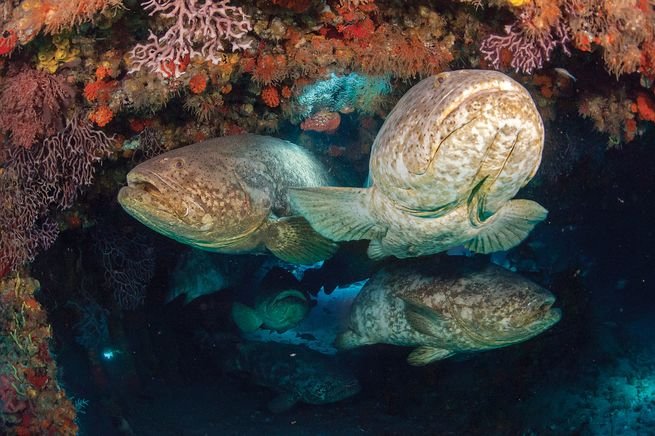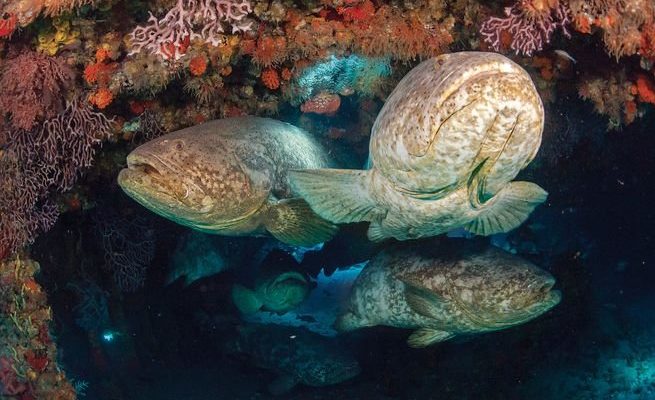
When you think of groupers, you might picture them as a delicious catch at your local seafood restaurant. But there’s so much more to them than just being tasty. From their unique physical traits to their intriguing behavior, groupers are an astonishing part of marine life. So, grab a cup of coffee and let’s dive into ten cool things you might not know about these incredible fish.
1. They Come in Different Shapes and Sizes
Groupers belong to the Epinephelidae family, which means there’s a whole variety of them! They range in size from small fish, like the rock hind, which can be about one foot long, to massive ones like the Goliath grouper that can exceed eight feet in length. Imagine swimming next to a fish that’s bigger than a small car!
Not only do they vary in size, but they also come in various colors and patterns. Some have vibrant hues that blend perfectly with their coral reef homes, while others sport bold stripes or spots. This diversity isn’t just for show; their colors help them camouflage from predators, making them clever little hide-and-seek experts.
2. They’re Masters of Camouflage
Speaking of camouflage, groupers are true masters at blending into their surroundings. Their skin is covered in special pigments that allow them to change color slightly based on their environment. Picture this: a grouper lounging on a coral bed, perfectly merged with the vibrant colors around it. This makes it easier for them to avoid predators and sneak up on their prey.
Their adaptive camouflage isn’t just a survival tactic; it also plays a role in their social interactions. Groupers use their color-changing ability to communicate with each other. During mating or territorial disputes, a grouper might change its colors to assert dominance or attract a mate. Isn’t that fascinating?
3. Groupers Have a Unique Hunting Style
When it comes to hunting, groupers take a rather unique approach. Unlike many fish that rely on speed, they’re more about strategy. These fish are ambush predators, which means they sit and wait patiently for their prey to come close before they strike.
Imagine a grouper lurking behind a reef, watching small fish swim by. When the moment is right, they’ll dart forward, often with surprising speed, to catch their meal. Their strong jaws and sharp teeth make it easier to capture slippery fare like fish and crustaceans. It’s a bit like playing a game of patience—waiting for the right time to make your move.
4. They Can Change Their Gender
Here’s something you might not expect: groupers can change their gender. This isn’t just a quirky feature; it’s actually a survival mechanism for these fish. Most species start their life as female and have the ability to transform into males later on.
Why would they do this, you might wonder? In some grouper species, when a male is removed from a population, the largest female can change into a male to maintain a breeding balance. This flexibility helps ensure the population thrives, adapting to changing conditions. It’s nature’s way of keeping things balanced!
5. Groupers Have a Long Lifespan
If you think about how long humans live, you might be surprised to learn that groupers can also live for many years—some even reach over 50 years! Their longevity is partly due to their position as top predators in their habitat.
This long life allows them plenty of time to grow and reproduce. It’s also why conservation efforts are so important for groupers. Overfishing and habitat loss can threaten their populations, which means we must be mindful of how we treat our oceans.
6. They’re Social Creatures
Groupers are not just solitary fish; they’re known for their social behavior, especially during spawning seasons. Many species form groups, often referred to as “schools,” to mate. Imagine a vibrant gathering of groupers—swimming together, displaying their stunning colors, and communicating in their own way.
Beyond mating, these schools provide safety in numbers. Groupers can watch each other’s backs and alert one another to danger. If one fish senses a predator, it’ll signal the rest, helping them all escape. It’s a great example of teamwork in the animal kingdom.
7. They’re Important for Ecosystem Health
The role of groupers in their ecosystem extends beyond their success as predators. They contribute to coral reef health by controlling the populations of smaller fish and invertebrates. Without groupers, certain species could overpopulate, leading to imbalances that can damage reefs.
So, when you see a grouper swimming by, consider its impact on the larger ecosystem. They play a crucial role in maintaining the health and balance of marine environments, and by protecting groupers, we’re also protecting the delicate ecosystems they inhabit.
8. Groupers Can Be Quite Vocal
Believe it or not, groupers have a unique way of communicating. They can produce a range of sounds, including grunts, growls, and even croaks. It might sound silly, but these vocalizations are essential for their social interactions.
During mating seasons, for instance, the sounds they make can attract potential partners or deter rivals. It’s like having a conversation under the sea! This vocal behavior shows how complex and social these fish can be, deepening our appreciation for their unique lifestyle.
9. They’re a Culinary Delight
If you’ve ever enjoyed a fish taco or a plate of grilled fish, there’s a good chance it was grouper. This fish is not only loved for its firm, white flesh but is also sought after for its mild, delicious flavor. Honestly, it’s one of those fish that just makes meal prep easy and flavorful!
However, it’s important to be mindful of sustainability when consuming grouper. Overfishing has led to declines in some grouper populations, so supporting responsible fishing practices helps ensure these fish are around for future generations to enjoy.
10. Conservation Efforts Are Key
With all these amazing traits, it’s no wonder groupers are a vital part of our oceans. Unfortunately, many species face threats from overfishing and habitat destruction. Conservation efforts are critical to their survival.
Organizations are working to promote sustainable fishing practices, creating marine protected areas to help these fish thrive. It’s vital for everyone—fishermen, consumers, and ocean enthusiasts—to do their part in ensuring groupers remain a staple of our waters for years to come.
In closing, groupers are truly remarkable fish, offering a glimpse into the wonders of marine life. Whether you admire them from the shore or enjoy them on your plate, knowing a little more about these gentle giants makes them even more special. By understanding their behaviors, habitats, and importance, we can foster a deeper connection with the ocean and its inhabitants. So next time you’re near the sea, take a moment to appreciate the grouper and all the cool things that make it unique!

